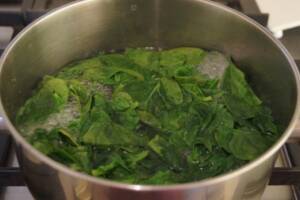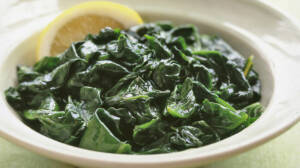
Like other dark green leafy vegetables, spinach is a nutritional powerhouse. High in vitamins and minerals, spinach is an excellent source of vitamin K & Vit A and a good source of minerals like iron, copper, phosphorous, zinc, selenium and vitamins like niacin, folic acid, Vit C and Omega-3-fatty acids. It contains a unique and beneficial mixture of phytonutrients, antioxidants, flavonoids and carotenoids. It is low in calories, fat free and a good source of fiber and is available all year-round.
Eating spinach decreases oxidative stress, helps to control obesity and diabetes, improves eye health, builds healthy bones and helps prevent heart diseases.
Spinach contains an array of micronutrients and phytochemicals. The major micronutrients in spinach are vitamins A, C, K and folate and the minerals, calcium, iron and potassium. Other nutrients present in smaller quantities include vitamin E, some B vitamins – thiamine (B1), riboflavin (B2) and B6 and the minerals magnesium, manganese and zinc. Spinach also provides fiber and has the additional advantage of being low in calories.
Selection
- Look for leaves that are crisp, young, tender and mostly whole (not torn), free from damage due to insect or handling.
- Leaves should be bright green with no dark, bruised patches or yellowing.
- Avoid soft leaves with thick, tough stems & yellowish green color as these are signs of decay.
- Choose spinach with thin, flexible stem for salads or recipes where the spinach is served raw.
- Thick, fibrous stems mean more mature, tougher plants, which are best suited for cooking.
Storage
- Store spinach loosely packed in sealed plastic bag in the refrigerator where it will keep for 3 to 4 days.
- Do not wash spinach before storing as exposure to water encourages spoilage.
Preparation Tips
Trimming
- Remove the stems before washing.
- Discard them or save them to add to a vegetable stock.
Washing
- Spinach should be washed very well since the leaves and stems tend to collect sand and soil.
- To wash, drop the spinach leaves into a large bowl of lukewarm water, stir them gently with your hands and then lift out the leaves to let the sand and grit settle.
- Next, empty and refill the bowl with clean water and wash the leaves again.
- Repeat this until there is no sand or grit on the bottom of the bowl and the spinach is clean.
- For using in salad, dry it by shaking it in a colander.
Raw Spinach
Raw spinach has a milder taste. Some of the essential nutrients found in spinach are more available to our bodies when consumed raw, such as folate, potassium, riboflavin, vitamin C and niacin. In the raw form, Vit K is bound to chloroplasts and is thus less available to the body.
Spinach is rich in lutein, a natural fat-soluble pigment which can reduce inflammation in immune cells. Lutein can be stored in immune cells and therefore it is possible to build up it’s reserve within the body. To obtain lutein, eat raw spinach in the form of salad or juice as it gets degraded by heat. You can make a smoothie by adding fat from dairy products, such as cream, milk or yoghurt. When the spinach is chopped into small pieces, more lutein is released from the leaves and the fat from dairy in smoothie increases the solubility of the lutein in the fluid.
One drawback of raw spinach is the presence of oxalic acid, which inhibits the absorption of essential nutrients like calcium and iron present in it.
Cooked spinach
The best way to retain antioxidants, vitamins and minerals when cooking fresh spinach is to opt for blanching, steaming, sautéing or microwaving.
Cooked spinach helps to absorb higher levels of vitamins A, E, K, protein, fiber, zinc, thiamin, calcium and iron. Important carotenoids, such as beta-carotene and zeaxanthin, also become more absorbable. Cooking spinach also reduces the amount of oxalic acid.
People who are prone to osteoporosis should consume cooked spinach as Vit K is more available in cooked form and it helps to direct the absorbed calcium in the body towards bones.
More availability of nutrients when spinach is consumed in raw form – folate, potassium, riboflavin, vitamin C, niacin and anti-oxidant lutein
More availability of nutrients when spinach is consumed in cooked form – vitamin E, K, protein, fiber, zinc, thiamin, calcium, iron, beta-carotene and zeaxanthin.
Blanching spinach

- Bring a pot of water to boil, dip the spinach in it for 1 minute.
- Take out the blanched spinach and immediately plunge it in a pot of cold water.
- Blanched spinach is perfectly cooked, harmful bacteria are killed and the spinach does not lose its nutrients.
Steaming spinach

- This method usually helps retain the bright green color of the leaf, while leaving them tender.
- Bring a pot of water to boil and place a colander or steaming plate on top.
- Place the leaves in the colander and cover the pot.
- Steam for about 2-3 minutes until the leaves wilt.
Sautéing spinach
- Spinach can be sautéed quickly in a small amount of oil.
- It works well if the spinach has just been washed.
- Use a non-stick pan and 1 teaspoon of oil for 3 cups of chopped spinach.
- Be careful to stir and toss the leaves constantly.
- The cooking time is short, only 2-3 minutes.
- Spinach can also be sautéed in broth or stock. Be prepared to add more stock to the pan as it evaporates.
Microwaving spinach
- To steam spinach in the microwave, place the leaves in a microwave-safe bowl while they are still wet.
- If the leaves are still wet, there is no need for additional water.
- Cover with a microwave-safe lid or a piece of plastic wrap.
- Leave one corner of the plastic wrap open to allow moisture to escape during cooking.
- Cook until tender. Cooking time will be around 3-5 minutes.
Seasoning spinach
- Spinach should be seasoned carefully because it has a mild saltiness to it.
- So never add too much salt at one go. Always taste and season.
Precautions while eating spinach
On Warfarin
Spinach contains large amounts of vitamin K. Vitamin K is used by the body to help blood clot. Warfarin is used to slow blood clotting. By helping the blood clot, spinach might decrease the effectiveness of warfarin. Eat tender young leaves of raw baby spinach, if you are on warfarin as Vit K is bound to chloroplast in the raw form and is unavailable.
Eating both cooked and raw spinach, by preparing it in different ways, in different health conditions is ideal for a healthy diet.

